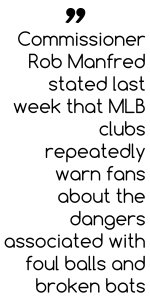On August 30, 2010 a six year old girl was sitting with her father behind the visiting team’s dugout at a baseball game at Turner Field. At the bottom of the fourth inning, the Braves outfielder Melky Cabrera hit a foul ball. That ball struck the child in the head, fracturing her skull in 30 places and causing a traumatic brain injury.
 The girl’s father, Fred Fletcher, filed a lawsuit against the Atlanta Braves. In the filing, Fletcher cited the fact that Cabrera (who now plays for the Chicago White Sox) was suspended for 50 games due to testing positive for testosterone. The filing requested that MLB turn over documents relating to that investigation. Lawyers for Fletcher contend that the use of steroids makes players hit the balls harder, giving fans in the stands less time to get out of the way of foul balls.
The girl’s father, Fred Fletcher, filed a lawsuit against the Atlanta Braves. In the filing, Fletcher cited the fact that Cabrera (who now plays for the Chicago White Sox) was suspended for 50 games due to testing positive for testosterone. The filing requested that MLB turn over documents relating to that investigation. Lawyers for Fletcher contend that the use of steroids makes players hit the balls harder, giving fans in the stands less time to get out of the way of foul balls.
Previously, the Braves have stated that they would increase the size of the netting around the foul line from 10 feet to 35 feet. This would raise the netting to the same height as the netting behind home plate. It should be noted that these improvements will only be installed at Turner Field. It has not been disclosed whether SunTrust Park, the new stadium currently under construction, will have the extended netting.
Fletcher’s lawsuit seeks damages for his daughter’s pain and suffering, the cost of her medical treatment, and compensation for her diminished ability to work and her future earnings. Recently, Fletcher and his lawyers added MLB as a defendant, citing that the League has a lot of input over decisions to install netting, the lawsuit contends that MLB was negligent by not taking steps to ensure that fans were safe during their games.
In response, Baseball Commissioner Rob Manfred stated last week that MLB clubs repeatedly warn fans about the dangers associated with foul balls and broken bats. Still, he contended that the League could do a better job of making fans aware of the dangers associated with individual stadium seating sections.


